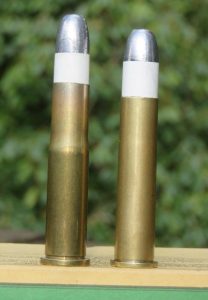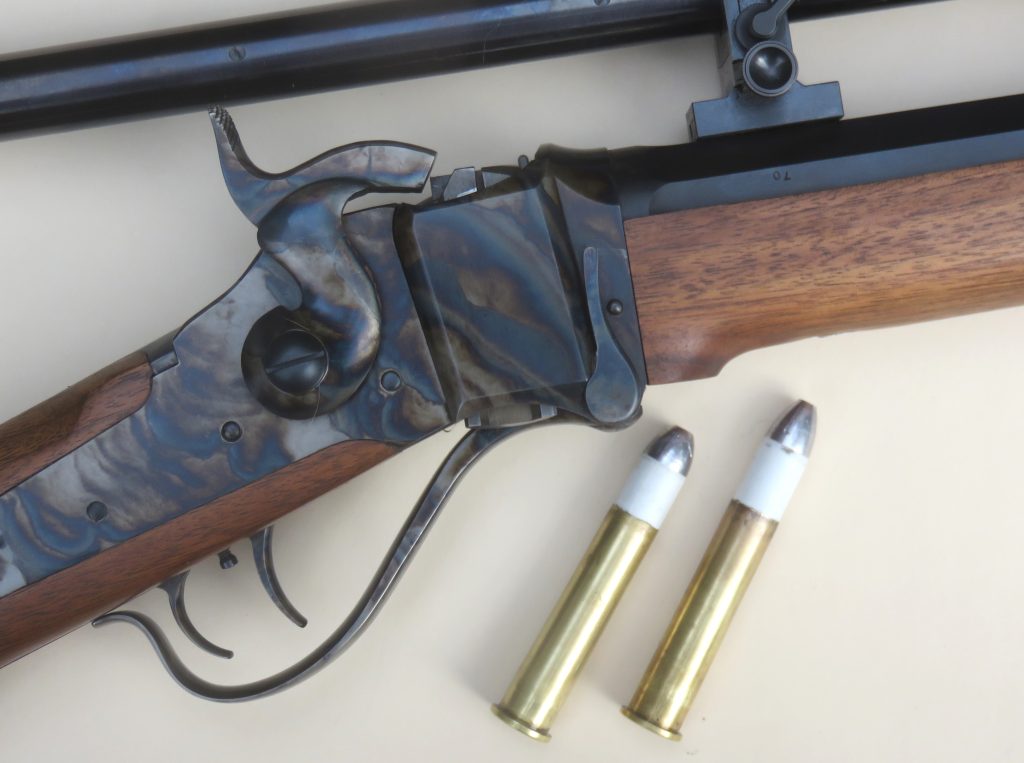
By Mike Nesbitt, Contributing Editor
This story was hinted at in a previous article on duplicating early loads with grease groove bullets for the .45-70 and, I admit, getting back to this subject took me longer than what had been intended.
So, if you’ve been waiting for it, I do apologize for the delay, but now that it is here, I hope you think it was worth waiting for.
Paper patched bullets, of course, were very popular in the 1870s and later. They were, in fact, our first jacketed bullets. The paper wrapping’s only purpose was to separate the lead of the bullets from the sides of the bore, to prevent, or at least reduce, the possibility of leading, where thin flakes or a coating of lead adheres to the bore. The idea of using paper patched bullets got a good start with muzzleloading rifles using elongated bullets, loaded through a false muzzle which was removed prior to firing the rifle. Sometimes those muzzleloaders were actually cartridge guns where the powder and primer were loaded from the breech, but the bullets were still loaded from the muzzle. Such rifles were usually heavy benchrest guns, or sniper rifles from the Civil War era. And, in general, their accuracy was outstanding.
The use of paper patched bullets was quickly adopted for cartridges, in the late 1860s, when the .40-70 Sharps, the .44-77, and the .50-70 were introduced. The government load for the .50-70 did not use a paper patched bullet but the civilian or sporting load for that famous fat cartridge did and they were loaded with paper patched bullets at least up to World War I. This information is a preview, so to speak, to our subject of paper patched bullets for the .45-70 but then we must remember that the .45-70 was a late-comer compared to those earlier cartridges.
When talking about early loads for the .45-70 we must remember that the military loads prior to 1881 used only the 405-grain bullets, for both rifle and carbine loads. During that same time, the civilian or sporting loads used several types of bullets, primarily paper patched. Those bullets ranged from 400 grains to 550 grains. Speaking only about the 550-grain bullets just for a moment, there were at least four different styles, some pointed and others with various shapes to the bullets’ noses.
Also, those early loads for the .45-70 were all intended for single shot rifles. The first lever action repeater to appear was Marlin’s model of 1881. That rifle was rather overshadowed by the Winchester Model 1886 five years later. Then Marlin made their large Model 1895 for the .45-70 and similar cartridges later. Another repeating rifle for the .45-70 was the bolt action Winchester Hotchkiss, which had a tubular magazine inside the rifle’s buttstock. That rifle appeared in 1879 as some were entered in ordnance trials, hoping for military contracts. While a few sporting rifles were made, the Hotchkiss was never popular with sportsmen or hunters. So, the remainder of this story about early paper patched loads for the .45-70 will focus on ammunition for use in single shot rifles, such as the Sharps, the rolling blocks, and the Highwall.
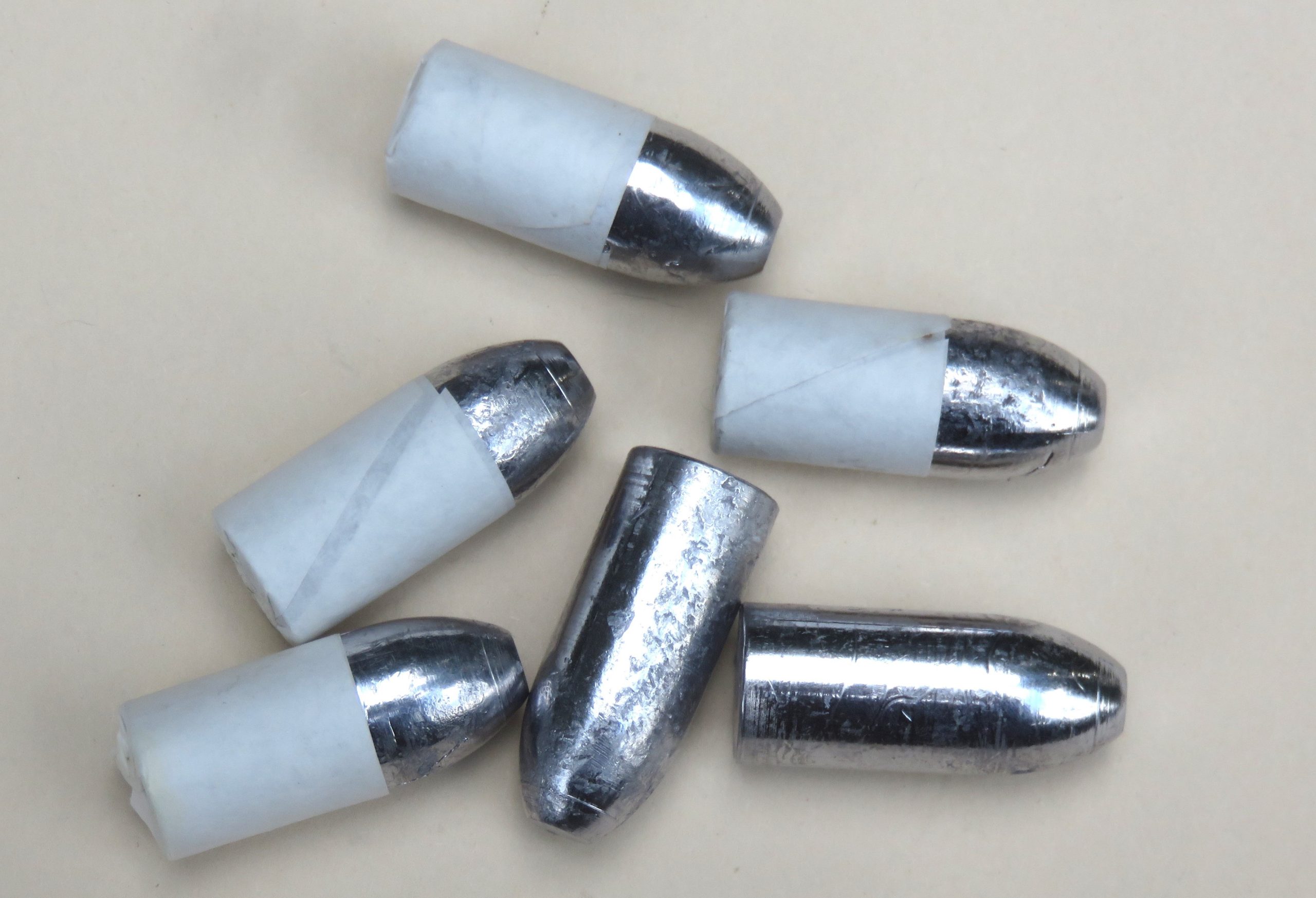
The reason we must exclude all repeating rifles from the ammunition we’re going to prepare for our single shot .45-70s is simple. The overall length of the cartridges will be too long to work through a repeating rifle’s action. These longer cartridges could be inserted individually into the rifle’s chamber and then fired. However, they’d have to be fired because the loaded cartridges would also be too long for the loaded round to be extracted and ejected from the repeater’s action. This was just as true in the 1880s as it is today and that’s why cartridge boxes for the ammo intended for Sharps rifles, for both paper patched loads and for grease groove bullets, were labeled with “Put up expressly for Sharps rifle” or something to that effect. This is being emphasized because if one of these paper patched loads is entered into the magazine of a repeating .45-70 rifle, the magazine might have to be taken apart just to get the cartridge out.
Now that our playing field has been reduced to only single shot rifles, let’s narrow our field of interest just a little more. As I mentioned, there were several weights of bullets and styles of bullets available for the .45-70 in paper patched loads. I will narrow that down to just two loadings which we’ll look at in detail so those loads can be duplicated and fired.
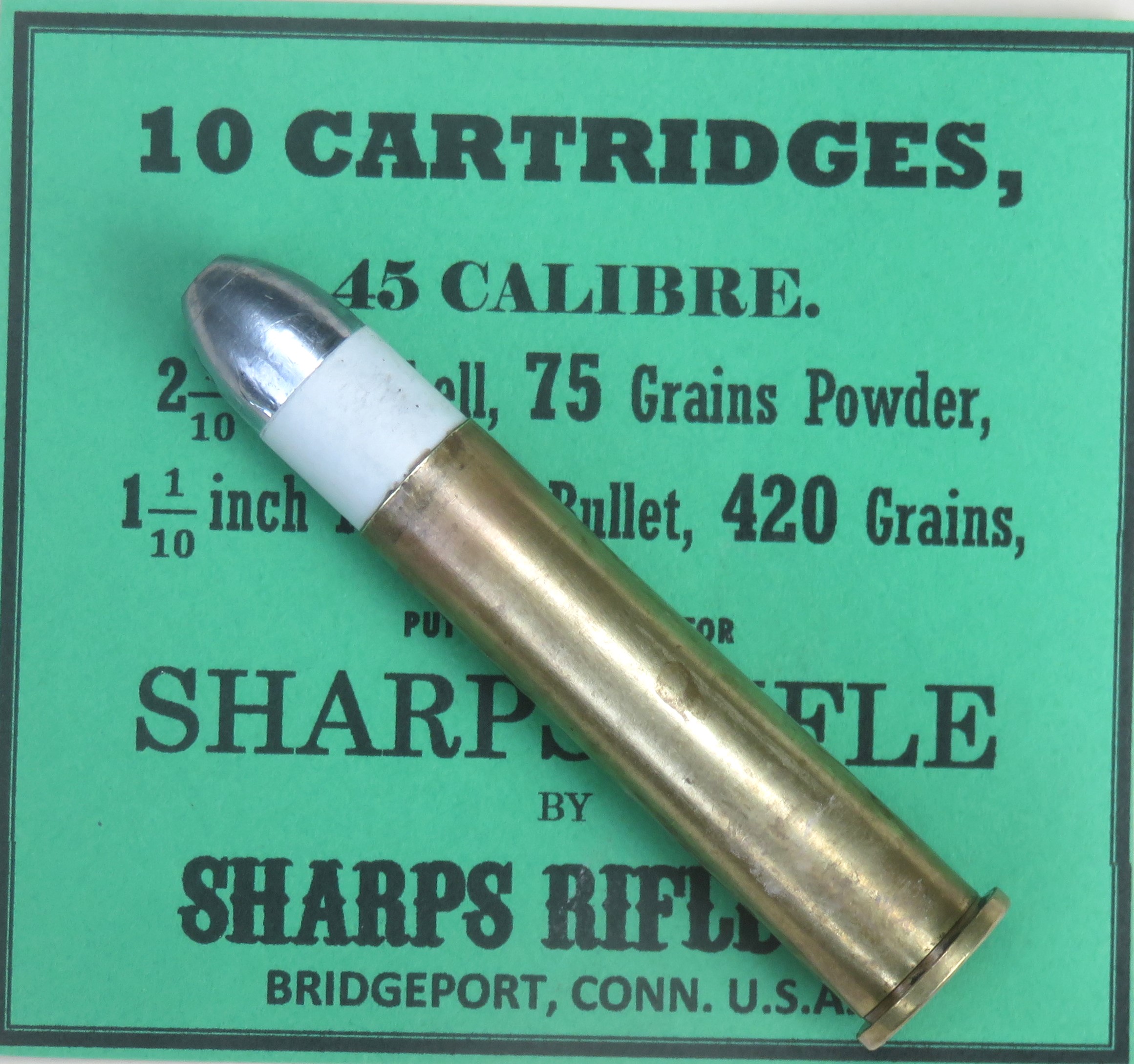
The first of these is my old favorite, the .45-75-420 Sharps. This loading used a soft lead 420-grain paper patched bullet over 75 grains of black powder in the standard .45-70-2 1/10” case and that load was still available in 1916 according to the Winchester catalog of that year. I call this my favorite loading because I used it for deer and black bear hunting in the 1980s with what I’ll call excellent success.
My 420-grain bullets are cast in a Rapine mold, #449420, which is no longer available. To duplicate this bullet, I’ll recommend going to Accurate Molds. This bullet drops from the mold at .449” diameter with maybe only a very slight taper. The bullets are wrapped with two wraps of 9-pound paper, which I buy from Buffalo Arms Company (buffaloarms.com). After the bullets are wet-patched, they are allowed to dry before attempting to load them into the cases.
When loading paper patched bullets, it’s always nice to know how far out the bullets can extend from the mouth of the case and still be chambered in the rifle. This might be different with each gun, as the lead to the rifling will allow. To find this out, take an empty case, perhaps sized so it will hold the bullet without letting the bullet fall out. Enter the bullet into the case but not deeply. Then try to chamber the case with the bullet in it. If you encounter resistance, that should mean the bullet is too far out of the case. Pushing a bit harder might “seat” the bullet back enough so the action can be closed. Extract the case with the bullet and try to be sure that the bullet does not move until you can measure the overall length. That will give you a good idea about the overall length of your paper patched loads, when chambered in a clean barrel.
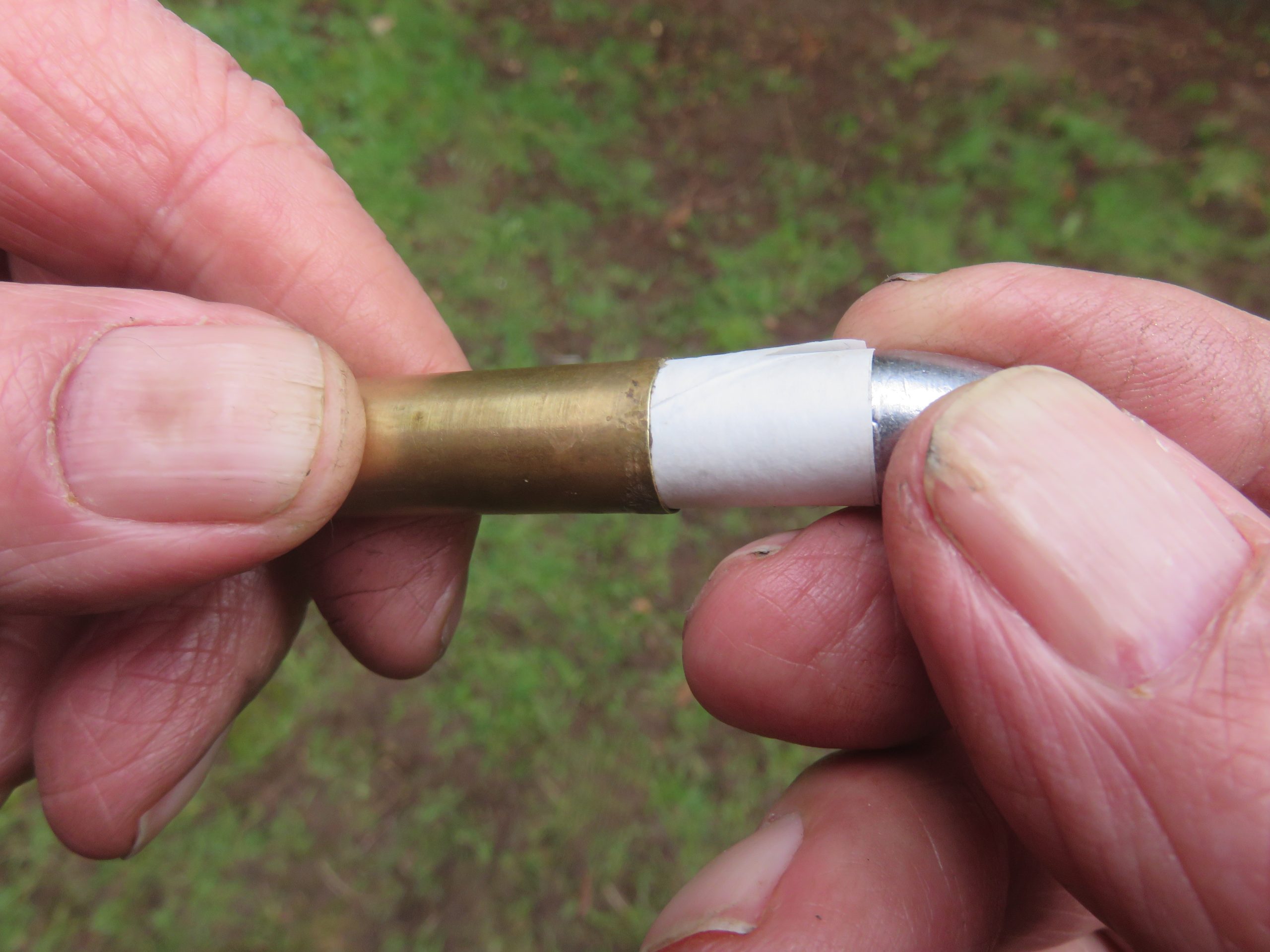
Cases are prepared, usually by running the empty fired brass through an expander die, and then priming them. Get the powder measure, and I do use and favor the Lyman 55 “Black Powder” version, set for almost 75 grains and we’ll use Swiss 1 1/2F powder for this job. I suggest “almost 75 grains” because each powder charge should be weighed and the charges can be brought up to a full 75 grains with a powder trickler. When the scale shows an even 75 grains of powder, we’ll put a case under the drop tube, and pour the powder in at the top of the tube. For this loading, a drop tube is basically needed in order to get all of the powder into the case.
With the powder charge in the case, add the wad of your choice and then compress the powder. The amount or depth of compression is up to you, depending on how deeply the bullet must be seated and if you will add lubricant to the load.
To lube or not to lube, that is the question. The answer lies in how the rifle and ammunition will be used. If you are going to shoot targets, or in a match, you don’t need to lube. Not using lube will require that you wipe the bore to clean it between shots. If you plan on hunting with the paper patched ammo, you’ll need lube in the load because you won’t want to take the time to clean the barrel between shots.
And adding lube will possibly change the amount of powder compression needed, to make room for the lube.
So, with the powder compressed to the desired depth in the case, add a “cookie” of lube if you are going to. For my own cartridges, I usually always add the lube, perhaps just over 1/8-inch in thickness. This can be done simply by melting some lube in a small tin to the desired depth, allow to cool, then inserting the open end of the case into the solid lube like a cookie cutter. Then add another card wad, maybe punched out of milk carton, over the lube. Then the bullet is seated down, with fingertips, to rest on top of the last wad. Finally, run the loaded cartridges through a taper crimp die and crimp well enough to hold the bullets in place. That makes the .45-75-420 loads ready for shooting.
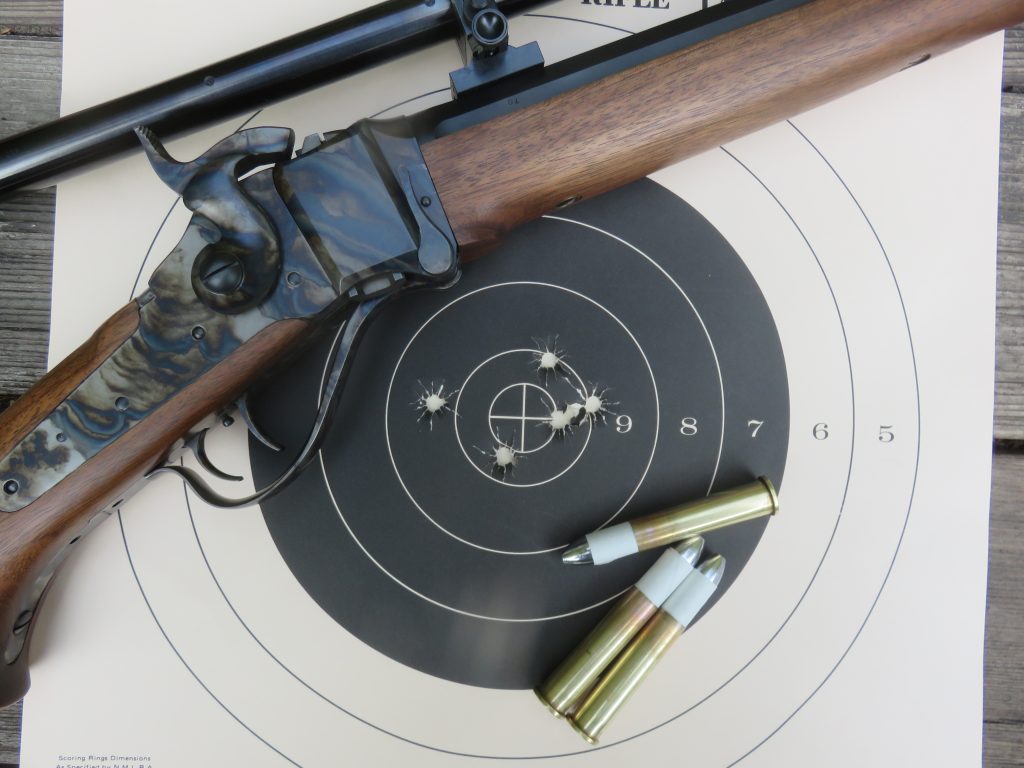
The next paper patched load I’ll talk about loading uses 500-grain bullets, duplicating an early sporting load, from a Tom Ballard mold, which is also not available anymore. If a bullet similar to this is desired, I recommend going to Buffalo Arms, where bullet molds are also made, or try Steve Brooks with his “True Bore” bullet molds (brooksmoulds.com). The 500-grain bullet would generally be a better choice for long range shooting.
The seating depth of the bullet should be checked again. The bullet will have a different shape than the 420-grain projectiles so it most likely will be accepted by the lead in the rifling differently. Once the seating depth for the bullet is known, the loading can proceed much like with the 420-grain bullets.
One immediate difference, to duplicate the old 500-grain loadings, we want only 70 grains of powder. We’ll stay with the Swiss 1½ Fg powder for this example and using a drop tube is still recommended. Compress the powder to the needed depth with an over-powder wad. As I’ve said previously, it is best to use a compression die for this but usually the expander dies, provided that does not have a de-capping rod, will suffice. Then add the grease cookie if you’re going to have lube beneath the bullet. Remember, that lube, and I do prefer BPC Lube from C. Sharps Arms, is for the following shot and not for the bullet in the case just ahead of it. Add a card wad over the powder and then seat the bullet with your fingertips. Complete the load by running the loaded cartridges through a taper crimp die to secure the bullets, and your 500-grain loads are ready to shoot.
Because we were talking about loads only for the .45-70, we were able to be rather specific in the descriptions. Perhaps those loadings will need just a bit of tweaking before you’re satisfied with their shooting and accuracy but that shouldn’t be required.
There is something very pleasing about using paper patched loads and some of our club’s shooters use them all of the time. Shooting paper patched bullets is certainly the way to really enjoy a blast from the past while firing the black powder “buffalo guns.”

